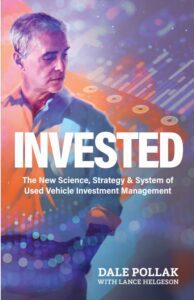In recent conversations and meetings with dealers, I’ve been describing how Variable Management and ProfitTime GPS represent a new day for dealers and their used vehicle departments.
The new day arrives from the way Variable Management and ProfitTime GPS help dealers evolve from simply managing their inventories to optimizing their used  vehicle inventories and the critical processes of appraising, acquiring and pricing every vehicle. The combination of optimized inventory and process leads to a higher level of management that, to date, most, if not all, dealers have yet to achieve.
vehicle inventories and the critical processes of appraising, acquiring and pricing every vehicle. The combination of optimized inventory and process leads to a higher level of management that, to date, most, if not all, dealers have yet to achieve.
The absence of a suboptimal used vehicle inventory and related process shows up almost everywhere you look:
Appraising: Today, variances among appraisers typically abound if you compare average Look to Book and Cost to Market percentages across appraisers, or examine how frequently they use default rather than accurately estimated reconditioning costs, or include notes/photos to detail a vehicle’s condition. There’s also very little consistency across appraisers in how they arrive at an appraisal amount—is it a true “retail-back” or a cost-up calculation? If the offer’s based on retail prices, how “correct” is the competitive set and the appraiser’s retail asking price reference for the car?
Pricing: In almost every dealership inventory I examine, I’ll see used vehicles priced in a manner that defies logic and reason. With a few questions, I’ll usually get dealers and managers to agree that the pricing decisions reflect someone’s belief or bias about the vehicle than the cold, hard reality a clear-eyed examination of the market reveals. The belief and bias works both ways—either asking too much for a vehicle or not asking enough. I also see plenty of instances where inattention to daily price management contributes to asking prices that are, to put it charitably, misaligned to the current market.
Acquisition: One of the key Performance Management initiatives at vAuto in the past two years has focused on coaching dealers to go beyond simply stocking a specific number of vehicles to a more granular approach, wherein you determine your optimal days supply for vehicles within specific inventory segments—vehicle type (i.e., sedan, SUV, pick-up), model year, price segment, etc. The end game is to develop a stocking strategy that guides the number and type of vehicles you acquire. Despite the effort, we still see dealers choosing to stock too many vehicles for no reasons other than a) the vehicle was available and b) someone liked the car.
The totality of such deficiencies across three of the most-critical areas of used vehicle operations has led me to conclude that simply having inventory and management isn’t enough any longer for sustained success. The fix rests with individual dealers working to optimize their inventories and related process to achieve a higher order of management and performance.
At our recent Access: Innovation event in Chicago, I shared the outlines of what I believe optimized inventory and process require. Here they are:
- Strategy. You can’t optimize anything without a specific destination, goal or target in mind. In used vehicles, the end goal is achieving your strategic objective. Your strategy might skew toward gross, volume or balance of both. In turn, this strategy should guide how your processes for appraising, acquiring and pricing vehicles occur. Your strategy represents the critical first step to optimize your inventory and related processes. A simple rule of thumb is that operating without a strategy tied to specific objectives, the opportunity for optimization never arrives.
- Communication of your strategy. You can’t just communicate your strategy in a conference room or off-site meeting and call it good. Every team member who plays a part in executing your strategy across appraising, acquisition and pricing needs to understand your strategic objective and the specific process-related tasks they should perform to achieve it. If your strategy isn’t clearly set and communicated, you can’t expect anyone to do the right thing or make the right decision day in and day out.
- Measurement of process execution to assess strategy alignment. The appraising, pricing and acquisition deficiencies I mentioned earlier aren’t necessarily indicative of managers who aren’t capable of more effective management. Rather, I believe the current state owes to the absence of a strategy or its clear communication across your team. Further, most managers currently lack the real-time means and visibility to effectively measure how well individual team members execute your strategy as they follow your process. Without this, managers can’t assess or ensure your team’s appraising, pricing and acquisition decisions fit your strategy or they don’t.
At Access: Innovation, I also shared how Variable Management and ProfitTime GPS help dealers achieve optimized used vehicle inventory and process. I’m excited for the dealers who have chosen to embrace the new day that’s dawned for their used vehicle departments. They are on the path toward a higher level of management and performance as they optimize their used vehicle inventories and process. I’ll be keeping in close touch with them and sharing their success stories here.
The post A New Day Dawns for Dealers through Inventory, Process Optimization appeared first on Dale Pollak.





